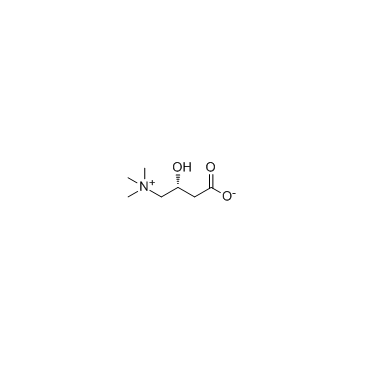L-Carnitine inner salt

L-Carnitine inner salt structure
|
Common Name | L-Carnitine inner salt | ||
|---|---|---|---|---|
| CAS Number | 541-15-1 | Molecular Weight | 161.199 | |
| Density | N/A | Boiling Point | N/A | |
| Molecular Formula | C7H15NO3 | Melting Point | 197-212 °C(lit.) | |
| MSDS | USA | Flash Point | N/A | |
|
Metabolic and tissue-specific regulation of acyl-CoA metabolism.
PLoS ONE 10(3) , e0116587, (2015) Acyl-CoA formation initiates cellular fatty acid metabolism. Acyl-CoAs are generated by the ligation of a fatty acid to Coenzyme A mediated by a large family of acyl-CoA synthetases (ACS). Conversely, acyl-CoAs can be hydrolyzed by a family of acyl-CoA thioes... |
|
|
Beneficial effect of butyrate, Lactobacillus casei and L-carnitine combination in preference to each in experimental colitis.
World J. Gastroenterol. 20(31) , 10876-85, (2014) To investigate the beneficial effect of the combination of butyrate, Lactobacillus casei, and L-carnitine in a rat colitis model.Rats were divided into seven groups. Four groups received oral butyrate, L-carnitine, Lactobacillus casei and the combination of t... |
|
|
Pregnancy and lactation alter biomarkers of biotin metabolism in women consuming a controlled diet.
J. Nutr. 144(12) , 1977-84, (2014) Biotin functions as a cofactor for several carboxylase enzymes with key roles in metabolism. At present, the dietary requirement for biotin is unknown and intake recommendations are provided as Adequate Intakes (AIs). The biotin AI for adults and pregnant wom... |
|
|
Biotin deprivation impairs mitochondrial structure and function and has implications for inherited metabolic disorders.
Mol. Genet. Metab. 116 , 204-14, (2015) Certain inborn errors of metabolism result from deficiencies in biotin containing enzymes. These disorders are mimicked by dietary absence or insufficiency of biotin, ATP deficit being a major effect,whose responsible mechanisms have not been thoroughly studi... |
|
|
Calcium Chloride in Neonatal Parenteral Nutrition Solutions with and without Added Cysteine: Compatibility Studies Using Laser and Micro-Flow Imaging Methodology.
PLoS ONE 10 , e0136894, (2015) Previous studies of compatibility of calcium chloride (CaCl2) and phosphates have not included particle counts in the range specified by the United States Pharmacopeia. Micro-flow imaging techniques have been shown to be comparable to light obscuration when d... |
|
|
Cheminformatics analysis of assertions mined from literature that describe drug-induced liver injury in different species.
Chem. Res. Toxicol. 23 , 171-83, (2010) Drug-induced liver injury is one of the main causes of drug attrition. The ability to predict the liver effects of drug candidates from their chemical structures is critical to help guide experimental drug discovery projects toward safer medicines. In this st... |
|
|
Translating clinical findings into knowledge in drug safety evaluation--drug induced liver injury prediction system (DILIps).
J. Sci. Ind. Res. 65(10) , 808, (2006) Drug-induced liver injury (DILI) is a significant concern in drug development due to the poor concordance between preclinical and clinical findings of liver toxicity. We hypothesized that the DILI types (hepatotoxic side effects) seen in the clinic can be tra... |
|
|
HMDB: a knowledgebase for the human metabolome.
Nucleic Acids Res. 37(Database issue) , D603-10, (2009) The Human Metabolome Database (HMDB, http://www.hmdb.ca) is a richly annotated resource that is designed to address the broad needs of biochemists, clinical chemists, physicians, medical geneticists, nutritionists and members of the metabolomics community. Si... |
|
|
The human serum metabolome.
PLoS ONE 6(2) , e16957, (2011) Continuing improvements in analytical technology along with an increased interest in performing comprehensive, quantitative metabolic profiling, is leading to increased interest pressures within the metabolomics community to develop centralized metabolite ref... |
|
|
Prediction of skeletal muscle and fat mass in patients with advanced cancer using a metabolomic approach.
J. Nutr. 142(1) , 14-21, (2012) Urine and plasma metabolites originate from endogenous metabolic pathways in different organs and exogenous sources (diet). Urine and plasma were obtained from advanced cancer patients and investigated to determine if variations in lean and fat mass, dietary ... |